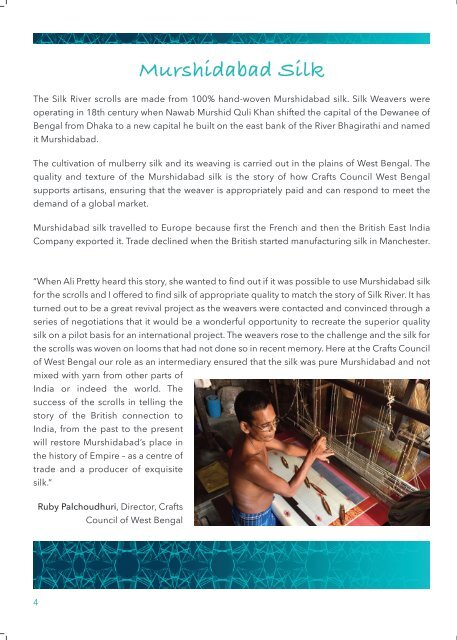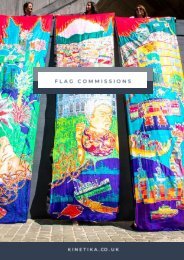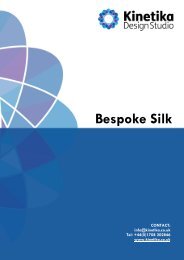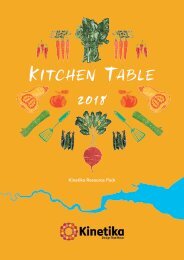Silk River Souvenir Programme
The souvenir programme for the Silk River project, an ambitious project which explores the unique relationship between London and Kolkata through artistic exchange between communities along the Thames Estuary and India’s Hooghly River. More info about the project: http://www.silkriver.co.uk
The souvenir programme for the Silk River project, an ambitious project which explores the unique relationship between London and Kolkata through artistic exchange between communities along the Thames Estuary and India’s Hooghly River. More info about the project: http://www.silkriver.co.uk
You also want an ePaper? Increase the reach of your titles
YUMPU automatically turns print PDFs into web optimized ePapers that Google loves.
Murshidabad <strong>Silk</strong><br />
The <strong>Silk</strong> <strong>River</strong> scrolls are made from 100% hand-woven Murshidabad silk. <strong>Silk</strong> Weavers were<br />
operating in 18th century when Nawab Murshid Quli Khan shifted the capital of the Dewanee of<br />
Bengal from Dhaka to a new capital he built on the east bank of the <strong>River</strong> Bhagirathi and named<br />
it Murshidabad.<br />
The cultivation of mulberry silk and its weaving is carried out in the plains of West Bengal. The<br />
quality and texture of the Murshidabad silk is the story of how Crafts Council West Bengal<br />
supports artisans, ensuring that the weaver is appropriately paid and can respond to meet the<br />
demand of a global market.<br />
Murshidabad silk travelled to Europe because first the French and then the British East India<br />
Company exported it. Trade declined when the British started manufacturing silk in Manchester.<br />
“When Ali Pretty heard this story, she wanted to find out if it was possible to use Murshidabad silk<br />
for the scrolls and I offered to find silk of appropriate quality to match the story of <strong>Silk</strong> <strong>River</strong>. It has<br />
turned out to be a great revival project as the weavers were contacted and convinced through a<br />
series of negotiations that it would be a wonderful opportunity to recreate the superior quality<br />
silk on a pilot basis for an international project. The weavers rose to the challenge and the silk for<br />
the scrolls was woven on looms that had not done so in recent memory. Here at the Crafts Council<br />
of West Bengal our role as an intermediary ensured that the silk was pure Murshidabad and not<br />
mixed with yarn from other parts of<br />
India or indeed the world. The<br />
success of the scrolls in telling the<br />
story of the British connection to<br />
India, from the past to the present<br />
will restore Murshidabad’s place in<br />
the history of Empire – as a centre of<br />
trade and a producer of exquisite<br />
silk.”<br />
Ruby Palchoudhuri, Director, Crafts<br />
Council of West Bengal<br />
4








